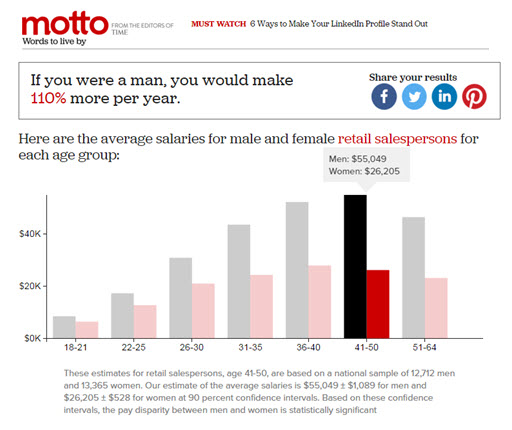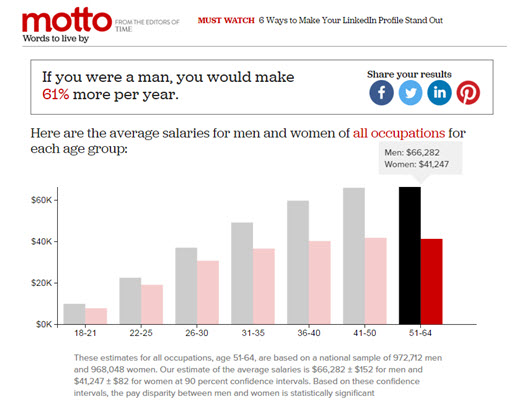Have you seen the Motto Gender Pay Gap Calculator? Just how extreme is the difference in your job or field? How much more would you earn if you were a man? How much less if you were a woman?
 The World Economic Forum Gender Gap Calculator has been around for several months now. It provides a window into a variety of factors illustrating the gender gap — earnings, workforce participation, literacy rates, life expectancy. In fact, we are told that the economic gender gap won’t be closed for more than 100 years.
The World Economic Forum Gender Gap Calculator has been around for several months now. It provides a window into a variety of factors illustrating the gender gap — earnings, workforce participation, literacy rates, life expectancy. In fact, we are told that the economic gender gap won’t be closed for more than 100 years.
In 2133, to be precise.
But Time’s Motto Gender Pay Gap Calculator is the one that has me mouth-agape and eyebrows raised. You’re likely to find yourself in a similar state. Now come on…
Aren’t you curious to see if you’re paid anywhere near parity with your other-gender colleagues? Interested in seeing the extent of the gap at various ages? Shouldn’t you contemplate what that means in terms of financial responsibilities at each stage in life?
The Time-Motto collaboration points out:
According to a new analysis by TIME and Motto, women earn less than men at every age range, from 15% less between ages 22 and 25 to a staggering 38% less between ages 51 and 64.
Seriously? That bad? And the 51+ age range?
This places us squarely in the years when many of us are attempting reinvention, reeling from gray divorce, struggling with aging parents, and still trying to cover the cost of kids in college… or hoping they’re willing to shoulder significant loans, and willing to pay rent if they move back into their old bedrooms.
Sample Job Categories; Interesting Results
Let’s take some examples. If you’re a marketer as I am, consider the category labeled “managers in marketing, advertising and public relations.” In my age demographic, 51 and over, were I male, I would be paid 53% more. 53%!
I also make my living in part through writing. A glance at “writers and authors” in the 51+ demographic shows that were I male, I would earn 49% more. Simply stated, for every $1.00 I’m paid, a man is paid $1.49 for the same work.
Let’s try teaching. It seems to me that the gap should narrow or be non-existent. Well, it turns out that the gap isn’t quite as bad for secondary school teachers. However, while we are almost at parity (hooray!) in the 26-30 age segment with a 1% advantage to the guys, in every other age group, the range is anything from 9% to 19%.
Do I even dare look at teaching in the fields of STM (Science, Technology, Math)?
Here’s a comparison that I find staggering. I looked at “retail sales” which seemed to me that salaries ought to be closer to parity. I was stunned to see this result: In the 41-50 age group, men are paid more than double what their female coworkers are paid. 110% to be exact.
Can anyone explain that to me? Any rationale at all for why female salaries for this category and demographic average $26,205 and the corresponding male figure is $55,049?
You can also view all occupations, which I did initially. We often throw around the 77 cents figure — that women in the US make 77 cents to the male dollar. In fact, the Time Motto Pay Gap Calculator indicates that it’s worse; it’s more like $.62 to the male $1.00.
Just How Bad Is the Gender Pay Gap Overall?
Using a national sample of more than 970,000 men and 960,000 women, the reported pay gap overall is as follows: Men make 61% more than women. With an average female salary reported as $41,247 and the average male salary, $66,282, the math delivers this: Women are paid $.62 to the male $1.00.
Did you get that?
Surprised? Appalled? Furious?
As an important point of reference, CNN Money tells us average American household income in 2015 is $53,657.
Now imagine a single female head of household trying to raise kids. Let’s take the figures at age 35, and across all occupations, men earn $49,129 while women earn $36,564. That’s nearly $13,000 less a year.
Surprised? Appalled? Furious?
Height, Weight, Ethnicity. Think Looks Don’t Matter?
 And let’s not forget that these averages do not reflect the discriminatory pay practices that persist when it comes to appearance. For example, tall men are paid more than their shorter counterparts; thinner women are paid more than those who are significantly overweight; and statistics on female pay for women of color reflect this comparison to the male dollar:
And let’s not forget that these averages do not reflect the discriminatory pay practices that persist when it comes to appearance. For example, tall men are paid more than their shorter counterparts; thinner women are paid more than those who are significantly overweight; and statistics on female pay for women of color reflect this comparison to the male dollar:
… Asian women earn 87 cents; White women earn 78 cents; African-American women earn 64 cents; Latina women earn 53 cents.
Surprised? Appalled? Furious?
And none of this includes the millions of workers in America who do not enjoy an employment relationship — in other words, 1099 workers in a growing “freelance” economy, with some estimates at 34% of the workforce, a figure that is expected to continue growing.
Yes, of course. There are exceptions. This is not about motivation; this is about systemic discrimination… and complacency.
I encourage you to visit the Time Motto Pay Gap Calculator. It’s an illuminating exercise. But how can we make it more than that? And shouldn’t men be just as irate, if not for themselves, for their daughters, their wives, their sisters, their mothers, their girlfriends?
- So what do we do with this knowledge?
- How do we turn indignation into meaningful action?
- If we aren’t indignant, why not?
- And how do we shrink that hundred year span to achieve global gender equity?
I welcome your thoughts.
You May Also Enjoy


I looked at this issue a year ago. I’m confused. I’m not sure who to believe. Like other issues I’ve investigated, getting to the so-called facts isn’t easy.
Women Earn Less Than Men: True or False? – Mar 8/2015
The gap is real. The factors are many. Do look at the details and their sources in the Time-Motto data, Mr. Belle. But the points in your post on conflicting (agenda-pushing) sources are well reasoned.
Over here, the German Focus magazine monitors the pay gap regularly. Its latest results are insane again.
After spending 2008-2013 stuck in extremely low paying legal assistant office jobs with no benefits and abusive bosses, I exited once and for all out of the pink collar ghetto and went into real estate.
My plan was that being paid on commission I’d have a more even chance of making what a male realtor can earn- however, this calculator shows a 58% pay gap between male and female realtors.
Good thing I’ve kept my PT transaction coordinator job for a male realtor as I also work hard at getting my own clients!
Thanks for stopping by, Nancy Kay. What has your own experience been relative to that 58% realtor gap per the calculator? Or too soon to tell?
On the surface, the pay disparity doesn’t make a lot of sense. From a theoretical perspective, you would think that employers would want to pay for quality (you know they always say “employees are our biggest assets”…). Of course, then you have to deal with the issue of what is considered quality. Progressive employers know that a workforce that is diverse across more characteristics is one with more diversity of ideas, and therefore more creative and less prone to suboptimal ideas and blind spots caused by group-think. On the other hand, you have many, many employers who believe the ideal employee is a tall, dark-haired, extroverted male, preferably ex-military (I’m exaggerating a little, but only barely).
If I look at the Time-Motto disparity for my particular profession and age (business management, age 61) I can guess that the difference would come from there being a higher percentage of male executives than female executives in that calculation. That may relate to the mindset I described of the ideal employee being an alpha-male.
When you just look at statistics from a male vs. female perspective, you can miss the forest for the trees. I suspect the bigger employment problem has to do with ups and downs in the national and international economies, where they improve for three or four years, decline precipitously for the same duration, and then repeat. The difficulty of obtaining work, particularly of like kind and pay, once you fall off the full employment treadmill, makes it almost impossible to do any kind of financial planning, much less be a full economic participant yourself. I can see where this would disproportionately impact a woman’s work and personal security, advancement and pay.
At one time it was taken as a given that a strong economy was one that was predictable and in which everyone could participate. What went around, came around, a rising tide lifted all boats, etc. That has been replaced by an attitude of predatory capitalism, where being kicked off the economic merry-go-round is viewed as a personal failure rather than a national failure.
The economic unpredictability would not be so bad if there were a national recognition that when part of the economy stops working, all of it suffers. I notice that France (and perhaps other countries?) adjusts the national workweek to fit the work available. It has always struck me as absurd that, in a country with high unemployment, you also have a typical workweek of near fifty hours for a salaried employee. Given that both the over- and underemployed are suffering, why can’t the work be spread? Abolishing the salaried employment mechanism would be a good first step here. There would still be an incentive to overwork employees to avoid paying benefits to those who would otherwise work, but that could be addressed.
Of course the knee jerk reaction to this would be “What about competitiveness” and “Isn’t that socialism?” My response would be, “What about all the very real costs that you don’t see, like lack of productivity because people are burned out, in bad health, holding on to suboptimum jobs because of apparent (but ultimately illusory) security?” There is a toll paid somewhere, either from lost opportunity or in the cost of remedial efforts – which are never as good as avoiding a problem to begin with.
Above all, what about the losses from the endless start-stop behavior in the global, national and personal realms (economicus interruptus)?
The bottom line is that there is no such thing as a problem that only affects one person or a small group. Instituting measures to keep those in difficulty working would help everyone, especially in times when no one seems immune. The tail saved could be anyone’s.
I am struck by so much to consider in your remarks, Robert. Among them, those hidden costs to ‘economicus interruptus’ as you call it… It seems three decades or more since anything beyond focus on the next fiscal quarter was the norm, certainly in the industry I was in and generally speaking, with clients of the past dozen years.
And this, so crushing to the human spirit:
“An attitude of predatory capitalism, where being kicked off the economic merry-go-round is viewed as a personal failure rather than a national failure.”
Much food for thought here, thank you.